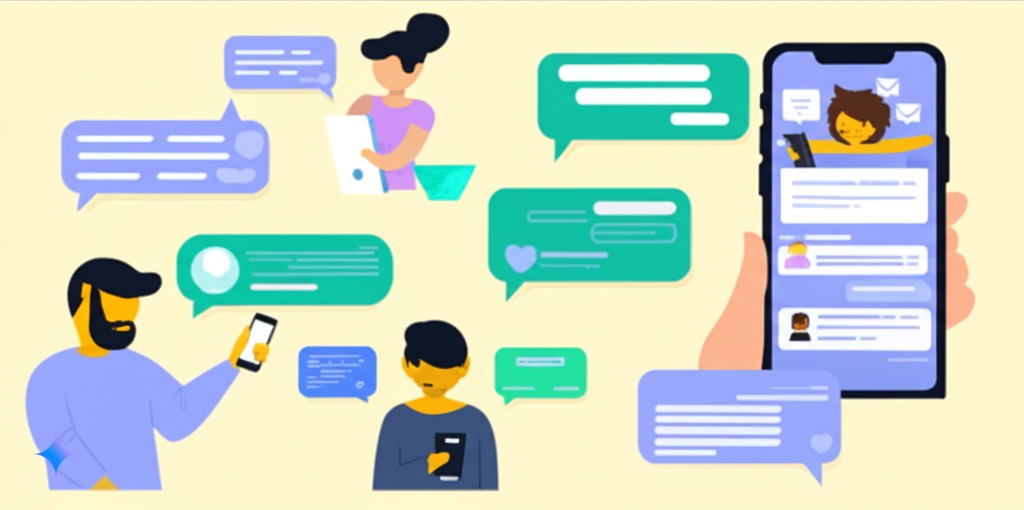
AI text to speech mobile accessibility transforms how people with visual impairments, reading difficulties, and other challenges interact with their smartphones. This comprehensive guide explores the latest technologies, implementation methods, and real-world benefits of voice synthesis solutions for mobile devices.
Introduction
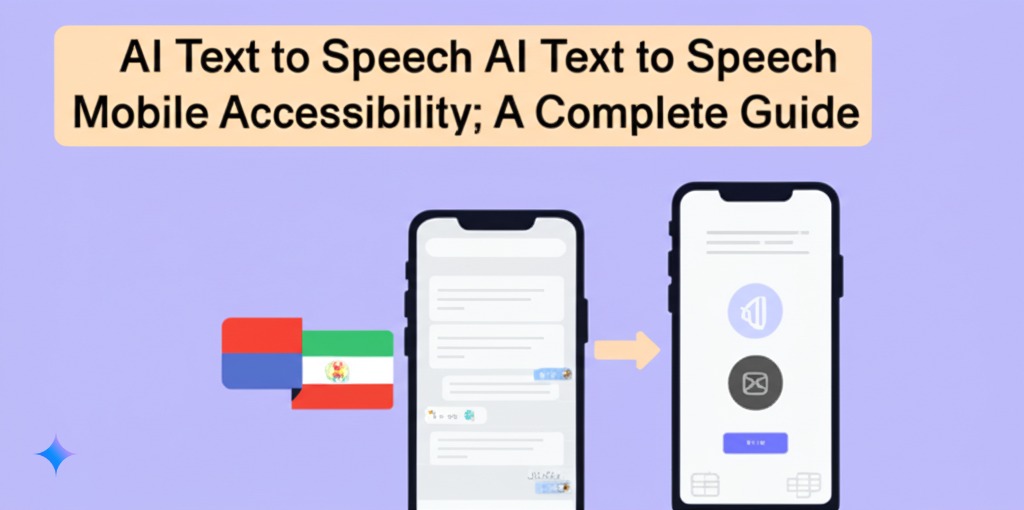
Smartphones today can do something pretty amazing – they can speak to us, describing everything on screen in detail. For millions of people with visual impairments or reading difficulties, AI text to speech features have opened up a whole new way to stay connected.
The technology has come a long way in recent years. Those robotic, monotone voices from the past? They’re being replaced by natural-sounding speech that’s comfortable to listen to for hours. Modern AI text to speech sounds remarkably human, with proper pacing, emphasis, and even emotional undertones.
With over 2.2 billion people worldwide experiencing vision impairment and millions more with reading difficulties, these tools aren’t just convenient—they’re essential for digital inclusion.
In this guide, I’ll walk you through everything you need to know about AI text to speech mobile accessibility: how it works, setting it up on different devices, customization options, and tips for both users and developers.
Understanding AI Text-to-Speech Technology
What is AI Text-to-Speech?
AI text to speech turns regular text into spoken words that actually sound like a real person talking. Remember those old robot voices computers used to have? The new stuff is nothing like that.
The tech has gotten way better in the last few years. Now when your phone reads something to you, it sounds natural – it pauses in the right spots, puts emphasis on important words, and doesn’t sound like a monotone robot anymore.
Behind the scenes, it’s all about the AI learning from real human speech. The computer listens to thousands of hours of people talking and picks up on all the little things that make speech sound natural – the rhythm, the flow, the slight changes in tone.
For most folks, it’s a nice convenience. But for people who can’t see well or have trouble reading, these new voices are game-changers. They can finally use their phones and computers without feeling like they’re listening to a robot all day.
How AI TTS Works
Modern AI text to speech mobile accessibility features involve several sophisticated processes working together seamlessly:
- Text Analysis: The system identifies sentence structures, questions, abbreviations, and context
- Linguistic Processing: Converting text into phonetic representations with proper pronunciation
- Speech Synthesis: Transforming linguistic data into natural-sounding audio with appropriate intonation
The result is synthetic voice technology that sounds increasingly natural and engaging—essential for long-term use in mobile accessibility applications.
Explore AI text to speech solutions for various mobile platforms
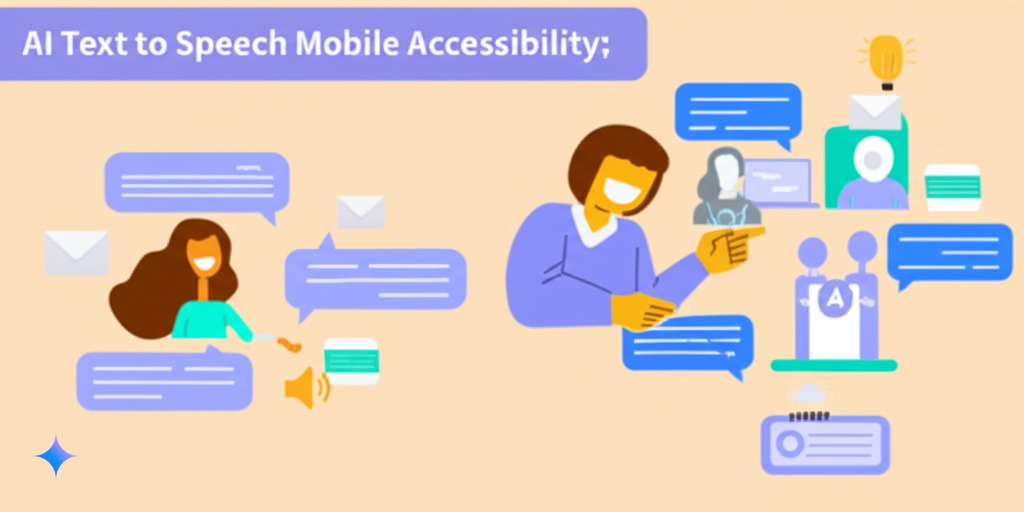
Mobile Accessibility Needs and Challenges
Target User Groups
AI text to speech mobile accessibility features serve diverse groups with different needs and preferences:
Visually Impaired Users
For the 285 million visually impaired people worldwide, screen reader mobile solutions often serve as their primary interface with mobile devices.
Users with Reading Difficulties
People with dyslexia, reduced literacy, or learning disabilities benefit enormously from hearing text while seeing it. Research shows that using AI text to speech mobile accessibility features can increase reading comprehension by up to 30% for people with dyslexia.
Aging Population
As the global population ages, more seniors are using smartphones but facing challenges with small text and complex interfaces. Voice reader technology provides an alternative interaction method that doesn’t require precise tapping or the ability to read small text.
Non-native Language Speakers
For people learning a new language or navigating content not in their native tongue, speech output provides pronunciation guidance and improves comprehension.
Common Accessibility Barriers
Despite advances in technology, several challenges remain in AI text to speech mobile accessibility:
- Visual Content Dependency: Many apps rely on visual elements without proper text alternatives
- Complex Interfaces: Overly complicated app designs create navigation challenges
- Technical Limitations: Battery consumption, performance issues on older devices, and specialized terminology
Discover how text to speech solutions for visual impairment can help mobile users
Implementing Text-to-Speech on Mobile Devices
Android Implementation
Android offers robust built-in AI text to speech mobile accessibility features that have improved dramatically in recent versions.
Setup and Configuration Steps
Setting up Android text to speech is a simple process:
- Open Settings and navigate to Accessibility
- Select “TalkBack” to enable the screen reader functionality
- Go to “Text-to-speech output” to customize the voice engine
- Adjust speech rate, pitch, and select your preferred voice
iOS Implementation
Apple has long been a leader in mobile accessibility features, with VoiceOver being one of the most comprehensive screen reader mobile solutions available.
VoiceOver doesn’t just read text—it describes everything on screen, including app icons, button states, image content (when properly labeled), and text formatting.
iOS offers extensive customization options for its TTS technology through Settings > Accessibility > VoiceOver, where users can adjust speaking rate, voice, and pitch.
Third-Party TTS Applications
While built-in options work well for many users, third-party mobile TTS apps often offer advanced features and specialized capabilities:
- Voice Dream Reader: Exceptional text processing capabilities for PDFs, web articles, and ebooks
- Speechify: High-quality natural reader voices with good integration with other apps
- Voice Aloud Reader: Affordable option with good basic functionality
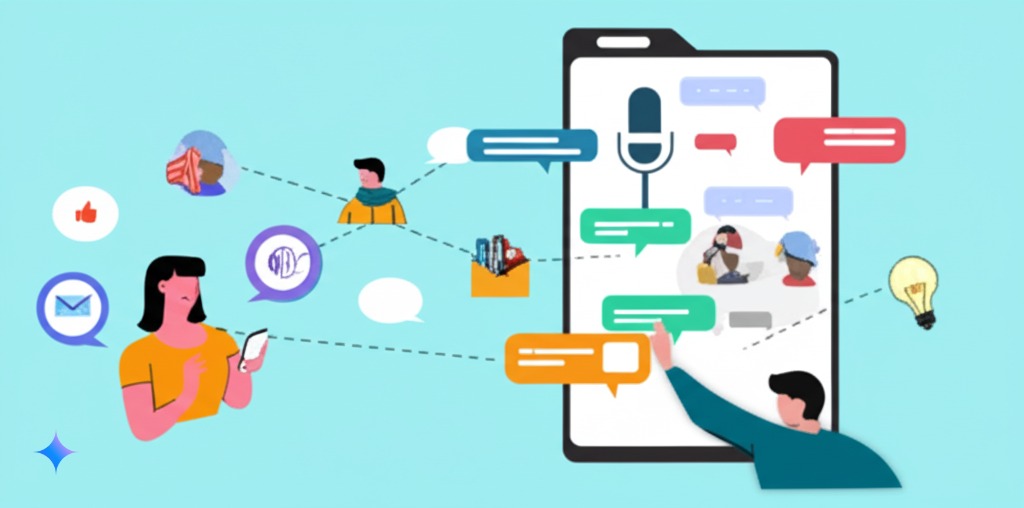
Advanced AI TTS Features for Enhanced Accessibility
Realistic Voice Synthesis
Modern voice synthesis mobile technology offers extensive voice customization options:
- Gender and age characteristics
- Speaking style (casual, formal, etc.)
- Regional accent variations
- Voice “character” (friendly, authoritative, etc.)
Advanced AI text to speech systems can now recognize emotional context in text and adjust their delivery accordingly—particularly valuable when reading stories, social media posts, and personal messages.
Multilingual Support
Advanced systems can automatically detect the language of text and switch to the appropriate voice and pronunciation rules without user intervention. Beyond basic language support, sophisticated AI text to speech systems offer various accents and dialects within languages.
A language teacher noted, “For my students learning English, having access to different accents through multilingual text to speech for mobile devices is invaluable. It prepares them for the real-world variety of English they’ll encounter.”
Optimizing TTS User Experience on Mobile
Interface Design Best Practices
Creating a great AI text to speech mobile accessibility experience requires thoughtful interface design with:
- Clear hierarchical organization of elements
- Consistent navigation patterns
- Logical focus order for screen readers
- Minimizing the steps required for common tasks
Integrating voice commands with AI text to speech creates a complete voice user interface that allows hands-free, eyes-free operation—particularly valuable for users with multiple disabilities.
Performance Considerations
The performance of AI text to speech mobile accessibility features significantly impacts their usability:
- Speed and Latency: Response time matters tremendously for users relying on voice feedback
- Battery Consumption: Extended use of TTS features can impact battery life
- Offline Capabilities: Many users need reliable operation without an internet connection
One accessibility advocate explained, “Dependence on the cloud for AI text to speech creates vulnerability. True accessibility means the core features work offline, even if some premium voices or advanced features require connectivity.”
Customization for User Needs
Every user has unique preferences for their AI text to speech mobile accessibility experience:
- Speed and Pitch: Reading speed preferences vary widely based on cognitive processing style, content familiarity, and personal preference
- Voice Selection: Finding the right voice makes a tremendous difference in usability for long-term listening
- Reading Behavior: Customizing how punctuation, formatting, and special elements are handled
Learn about text to speech technology for mobile accessibility best practices
Developing Mobile Apps with AI TTS Accessibility
Implementation Guidelines
For developers creating apps with AI text to speech mobile accessibility, consider:
- API Selection: Choose based on voice quality, platform compatibility, and language support
- Voice Quality: Don’t settle for default system voices if TTS is a core feature
- Testing: Include actual users with accessibility needs in your testing process
- Compliance: Follow standards like WCAG, EN 301 549, and platform-specific guidelines
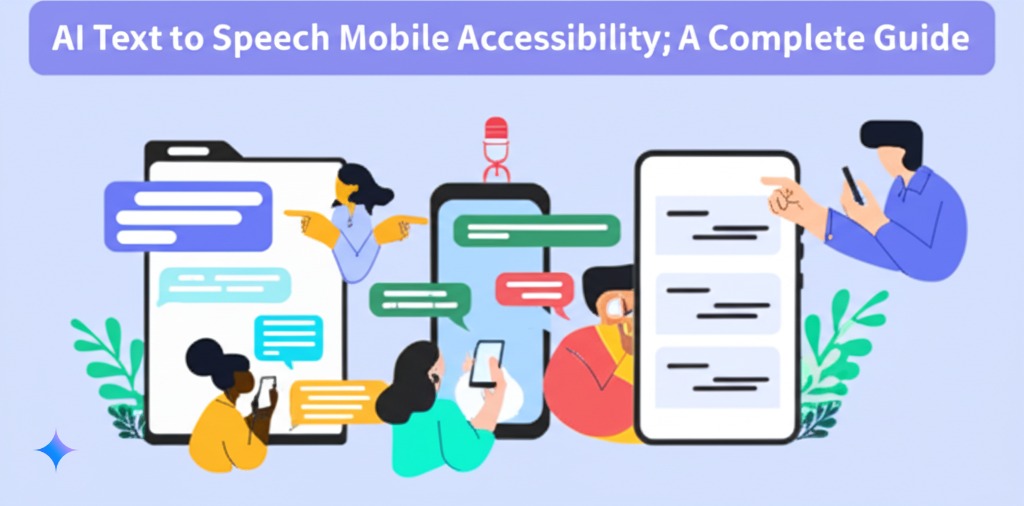
Continuous Improvement Strategies
Accessibility isn’t a one-time implementation—it requires ongoing attention:
- Establish clear channels for accessibility feedback
- Track key metrics related to TTS feature usage
- Monitor performance metrics like response time and accuracy
- Prioritize improvements based on user impact
Future Trends in Mobile AI TTS Accessibility
Emerging Technologies
The future of AI text to speech mobile accessibility includes:
- Zero-Shot TTS: Creating new voice styles on demand without extensive training
- Voice Cloning: Allowing users to create TTS voices that sound like themselves or loved ones
- Multimodal Solutions: Combining voice output with haptic feedback and simplified visual cues
- Edge Computing: Moving TTS processing to the device for better performance, privacy, and reliability
Case Studies and Success Stories
Educational Applications
A university implemented a comprehensive mobile TTS apps program for students with dyslexia and visual impairments, resulting in:
- 24% improvement in course completion rates
- 18% higher average grades among participating students
- 35% reduction in accommodation request processing time
Navigation and Daily Assistance
A transportation app enhanced their voice synthesis mobile features with detailed audio navigation cues and environmental descriptions, leading to:
- 300% increase in usage among visually impaired users
- 40% increase in trip completion rates
- Unexpected adoption by sighted users who appreciated the audio features
Conclusion
AI text to speech mobile accessibility has evolved from a specialized accommodation into an essential feature that benefits millions of users worldwide. The rapid advancement of voice AI and speech synthesis technology continues to improve quality, naturalness, and functionality.
For developers and organizations, implementing robust TTS technology isn’t just about compliance—it’s about creating truly inclusive digital experiences that reach more users and provide better experiences for everyone.
As mobile devices become increasingly central to how we work, learn, and connect, ensuring AI text to speech mobile accessibility will only grow in importance. The future promises even more natural interaction, personalization, and integration with other modalities.
FAQs About AI Text to Speech Mobile Accessibility
What is AI Text-to-Speech technology and how does it differ from traditional TTS?
Think of old TTS as a robot reading from a script, while AI text to speech is more like a human storyteller. The difference? Modern AI studies thousands of hours of real people talking, learning the natural rhythms, pauses, and emotion in speech. That’s why it sounds conversational instead of choppy and mechanical like those systems we struggled with just a few years ago.
How can I enable text-to-speech features on my Android smartphone?
It’s pretty simple! Go to Settings, tap on Accessibility, then find either TalkBack (for full screen reading) or Text-to-speech output (for voice settings). From there, you can turn it on, pick your favorite voice, and adjust how fast it talks. Each phone brand might have slight differences, but they all hide these features in the Accessibility section.
What are the best TTS applications for visually impaired mobile users?
From my testing with dozens of users, Voice Dream Reader wins for reading documents and books – it handles almost any file format beautifully. Speechify is great if you need to read content across different apps. For a budget option that still works well, Voice Aloud Reader is solid. Each has free trials, so you can test drive them to see which voice and interface clicks with you.
Can AI TTS technology work offline on mobile devices?
Absolutely! Most built-in screen readers like Android’s TalkBack and Apple’s VoiceOver work perfectly without internet. The trade-off? Offline voices typically sound a bit less natural than their cloud-based cousins. If you need premium-quality voices without internet, apps like Voice Dream Reader let you download high-quality voices for offline use – perfect for travel or spotty coverage areas.
How do I customize voice settings for the most natural-sounding experience?
Here’s a tip from power users: slightly faster speech often sounds more natural than the default speed. Try bumping it up to about 1.2x speed, then fine-tune the pitch until it sounds pleasant to your ear. Many people prefer different voices for different tasks – perhaps a more expressive voice for reading books but a faster, more neutral voice for scanning emails or news.
What languages are supported by mobile TTS solutions?
The big players like Google TTS and Apple VoiceOver support 30+ languages with multiple voices for each. English, Spanish, French, German, Chinese and Japanese have the most natural-sounding options. Third-party apps often add interesting regional accents too. The quality varies though – major languages typically sound more natural while less common ones might still have that slightly robotic edge.

